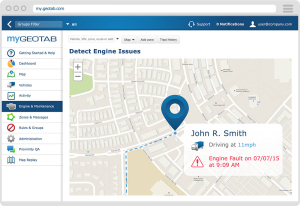Upgrading Fleet Safety in 2020: The Best Tech for Accident Prevention
There are plenty of challenges facing fleets this year. From preparing for upcoming changes to regulations, to the ever-present spectre of driver shortage — we’ve all got a lot to think about. Some of these challenges are positive; our digital landscape has changed shopping habits, meaning ecommerce shipping is one of the primary areas of custom for our industry. Online shopping has raised demand for premium services such as next day delivery, and we’ve had to adapt to this influx while remaining competitive.
However, one aspect of operating a commercial fleet that is a recurring concern is ascertaining driver safety; whether they are undertaking short journeys or going long-haul across the country. Thankfully, our world of advanced technology offers fleet managers and drivers some smart solutions. Though historically the freight industry has been relatively slow in taking advantage of these platforms, many are starting to understand how they can be integrated into our working practices to improve efficiency and safety.
We’re going to take a look at a few of the key areas in which technology is making a difference to accident prevention this year. What interesting gadgets and infrastructure developments are on trend, and what is coming up the pipeline? When looking to upgrade fleets, where should managers be considering investment?
Automation
Let’s face it, any article or debate regarding driver safety is — sooner or later — going to come back around to automation. While fully self-driving vehicles could result in some huge benefits for safety, we are unlikely to see much practical progress over the next few years. That said, fleets can adopt technology that uses elements of automation that still rely on some degree of driver control; as defined in the Society of Automotive Engineers’ levels 0-2 of vehicle automation.
The most practical tech is often to be found in driver assistance options. Ford has begun to introduce automatic emergency braking as a standard feature on 2020’s Transit models. These types of collision avoidance technologies utilize sensors, which not just detect when obstacles appear, but also when the driver fails to respond — sending signals to the vehicle to react accordingly. The popularity of such systems is growing largely due to the fact that sensors used in these and other items in the internet of things (IoT) are dropping drastically in price, making connected tech more affordable for many fleets.
We can also expect to see greater usage of adaptive cruise control systems. These utilize sensors to monitor the speed and position of the vehicle ahead on the road, and even lanes, adjusting accordingly to an appropriate, safe speed. While a few manufacturers — GMC, Fiat, and Ram among them — are starting to build this tech into their newer vehicles, it is an option for fleets to have installed on current assets. However, with the rollout of 5G networks expected to begin this year, we may be seeing more examples of similar technology. The mobile tech network upgrade will put in place minimal latency connections, meaning that gadgets that operate on vehicle to vehicle (V2V systems) will become more reliable, and may well grow in popularity.
Video
One of the exciting things about exploring new tech in fleets, is the point at which we realise that familiar gadgets can be used in ingenious ways that keep drivers safe. With the advent of lower cost camera systems, and reliable wireless transmission, the fleet industries have really started to embrace a wealth of possibilities that video has to offer.
From a driver’s perspective, cameras are starting to be embraced as a means to reduce risks the can arise from limited visibility. While cameras for blind spots have been around for some time, manufacturers have begun to build in smart detection elements. Such as the Dometic CAM1000 which not only transmits the rear image to drivers, but is able to clearly distinguish pedestrians and cyclists from stationary objects, and alerts the driver accordingly. Some manufacturers are going further, by using multiple cameras to effectively render a load invisible to drivers. The Valeo XtraVue Trailer system, designed for drivers who tow large loads, captures live images from multiple points around the load, combining them so that the driver receives an single image in the monitor that provides the full picture of activity behind the vehicle.
While there has been some resistance from drivers with regard to in-cabin cameras, both fleets and employees are beginning to see that they have a vital role to play in on-going training to ensure accident prevention. Recently, fleet tracking specialists GeoTab teamed up with video telematics provider Lytx on a collaborative fleet safety project. This allows fleet managers to receive a greater quality of data on journeys, including video assets that provide important information on driver behavior. Fleet managers can then use this information to give vital feedback to drivers to improve safety, efficiency, and adherence to legislation.
Tracking
Regulatory compliance can be a difficult area, particularly when there are variations from state to state. We know that drivers training to get the CDL licence in Florida will be subject to requirements and restrictions that their counterparts in Massachusetts or Texas may not experience. Certainly, local training schools should have the expertise to keep new drivers abreast of both state and federal regulations. But once they’ve gained their basic qualifications, how can fleets help make certain that both new recruits and more experienced drivers are remaining safe on the roads and meeting the seemingly ever changing regulatory compliance?
Technology for tracking certainly isn’t new, and as a result of regulations the majority of fleets should be well used to utilizing EDLs by now. However, fleet managers who are committed to safety in 2020 are exploring smarter methods of utilizing tracking technology and accompanying apps. Mobile workforce management (MWM) software is becoming more advanced, and with various sensor technology becoming much more affordable, there are opportunities to capture a wider array of data to improve safety. In this expanding field of utilizing advanced telematics, GoGPS has emerged as an forerunner; developing applications which combine the newest technology with an innovative blend of camera and GPS systems, to create fleet tracking packages that are making a serious impact on driver safety, fleet efficiency, and the environment.
Many fleets tend to use basic MWM to keep track of scheduling and assets, and the visual, user-friendly nature of this software can help keep drivers within regulation hours and distances, and make alterations easily as laws change and develop. Embedded telematics sensors on the vehicle can help to monitor performance of the vehicle, coupled with an MWM managers can review the length and severity of their use, and schedule maintenance that can prevent breakdowns and accidents. MWMs that work alongside GPS can also be monitored for changing road conditions, allowing the manager to visually communicate route adjustments to the driver to avoid both disruption and the likelihood of incidents.
Ralf Llanasas
Content Editor / CDLKnowledge.com







